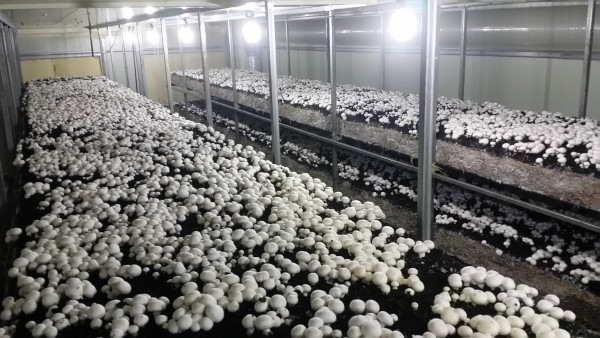양송이 재배는 5단계로 구분됩니다.
본문
The following main stages ("phases") can be distinguished in the production of modern mushroom compost:
- Phase I: mixing the raw materials of the compost (cereal straw, chicken and horse manure, water and gypsum) as homogeneously as possible and then carrying out the majority of the decomposition processes;
- Phase II: (indoor pasteurization): the raw, Phase I compost is fed into indoor pasteurization tunnels where, after appropriate pasteurization steps, the composting processes are completed. After the pasteurization, a base is obtained which can be successfully taken over by the button mushroom mycelium. The compost after pasteurization is free from pathogens and pests and a suitable source of nutrients for the fungus. Phase II compost is the compost mixed with spawn.
- Phase III: After the Phase II mushroom compost has been spawned, the pasteurized compost is returned by the composting plants to another pasteurization tunnel for spawn-running which takes 14-16 days. It takes place under fully controlled and hygienic conditions.
- Phase IV: means a compost covered with casing soil, where the entire cover layer is already spawned with mycelium and pinheads are appeared.
- Phase V: means harvesting.
다음 주요 단계 ( "단계")는 현대 버섯 퇴비 생산에서 구별 할 수 있습니다.
- 1 단계 : 퇴비의 원료 (곡물 짚, 닭 및 말 분뇨, 물 및 석고)를 가능한 한 균질하게 혼합 한 다음 대부분의 분해 과정을 수행합니다.
- 2단계: (실내 저온 살균): 1단계 퇴비는 적절한 저온 살균 단계를 거친 후 퇴비화 과정이 완료되는 실내 저온 살균 터널로 공급됩니다. 저온 살균 후, 단추 버섯 균사체에 의해 성공적으로 인수 될 수있는 염기가 얻어집니다. 저온 살균 후의 퇴비는 병원균과 해충이 없으며 곰팡이에 적합한 영양소 공급원입니다. 2단계 퇴비는 산란과 혼합된 퇴비입니다.
- 3 단계 : 2 단계 버섯 퇴비가 생성 된 후 저온 살균 된 퇴비는 퇴비화 공장에서 14-16 일이 소요되는 산란 실행을 위해 다른 저온 살균 터널로 반환됩니다. 완전히 통제되고 위생적인 조건에서 이루어집니다.
- 4 단계 : 케이싱 토양으로 덮인 퇴비를 의미하며, 전체 피복층이 이미 균사체로 생성되고 핀헤드가 나타납니다.
- 5 단계: 수확을 의미합니다.
- Phase I: mixing the raw materials of the compost (cereal straw, chicken and horse manure, water and gypsum) as homogeneously as possible and then carrying out the majority of the decomposition processes;
- Phase II: (indoor pasteurization): the raw, Phase I compost is fed into indoor pasteurization tunnels where, after appropriate pasteurization steps, the composting processes are completed. After the pasteurization, a base is obtained which can be successfully taken over by the button mushroom mycelium. The compost after pasteurization is free from pathogens and pests and a suitable source of nutrients for the fungus. Phase II compost is the compost mixed with spawn.
- Phase III: After the Phase II mushroom compost has been spawned, the pasteurized compost is returned by the composting plants to another pasteurization tunnel for spawn-running which takes 14-16 days. It takes place under fully controlled and hygienic conditions.
- Phase IV: means a compost covered with casing soil, where the entire cover layer is already spawned with mycelium and pinheads are appeared.
- Phase V: means harvesting.
다음 주요 단계 ( "단계")는 현대 버섯 퇴비 생산에서 구별 할 수 있습니다.
- 1 단계 : 퇴비의 원료 (곡물 짚, 닭 및 말 분뇨, 물 및 석고)를 가능한 한 균질하게 혼합 한 다음 대부분의 분해 과정을 수행합니다.
- 2단계: (실내 저온 살균): 1단계 퇴비는 적절한 저온 살균 단계를 거친 후 퇴비화 과정이 완료되는 실내 저온 살균 터널로 공급됩니다. 저온 살균 후, 단추 버섯 균사체에 의해 성공적으로 인수 될 수있는 염기가 얻어집니다. 저온 살균 후의 퇴비는 병원균과 해충이 없으며 곰팡이에 적합한 영양소 공급원입니다. 2단계 퇴비는 산란과 혼합된 퇴비입니다.
- 3 단계 : 2 단계 버섯 퇴비가 생성 된 후 저온 살균 된 퇴비는 퇴비화 공장에서 14-16 일이 소요되는 산란 실행을 위해 다른 저온 살균 터널로 반환됩니다. 완전히 통제되고 위생적인 조건에서 이루어집니다.
- 4 단계 : 케이싱 토양으로 덮인 퇴비를 의미하며, 전체 피복층이 이미 균사체로 생성되고 핀헤드가 나타납니다.
- 5 단계: 수확을 의미합니다.
